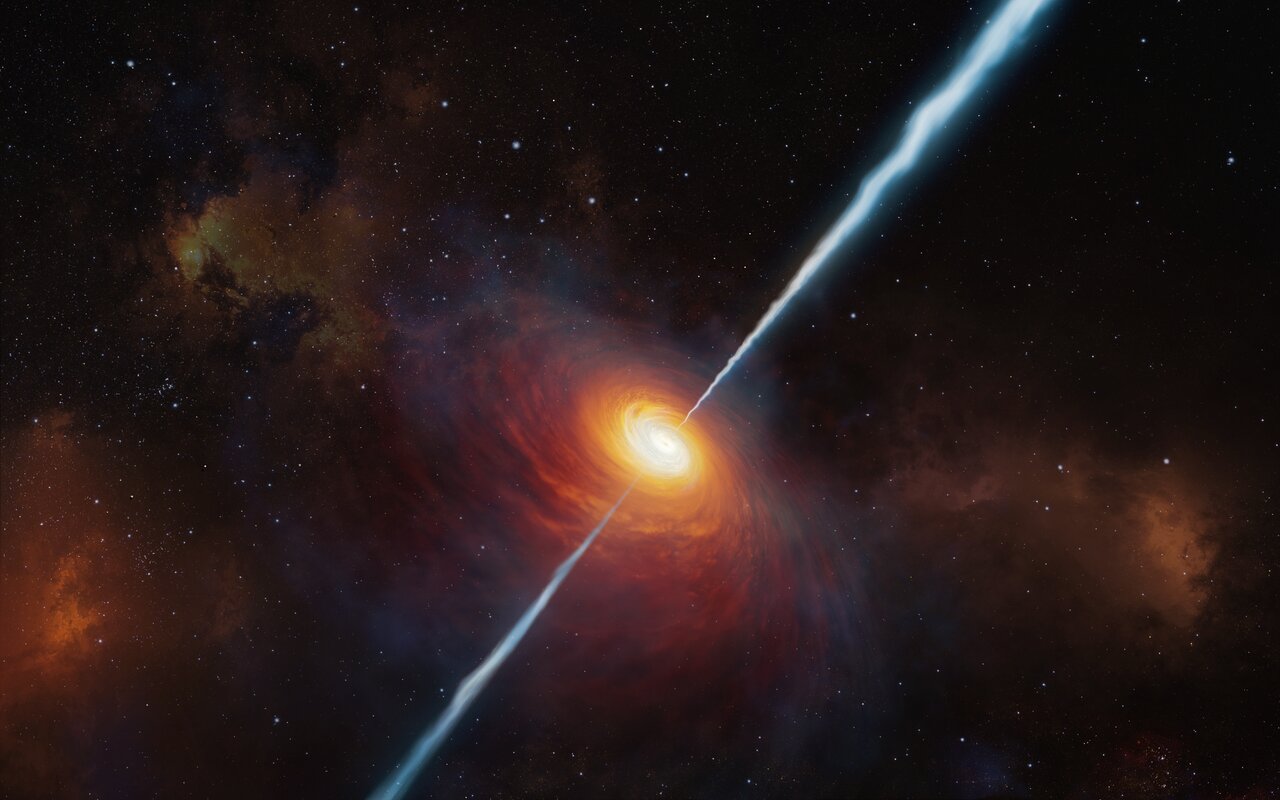Universe's oldest known quasar discovered 13 billion light-years away
Astronomers have found the farthest known source of radio emissions in the universe: a galaxy-swallowing supermassive black hole.

Astronomers have discovered the most distant and ancient single source of radio emissions in the known universe. That source is one of the universe's most powerful particle accelerators: a quasar 13 billion light-years from Earth spewing jets of particles at nearly the speed of light.
Quasars are some of the oldest, most distant, most massive and brightest objects in the universe. They make up the cores of galaxies where a rapidly spinning supermassive black hole gorges on all the matter that's unable to escape its gravitational grasp. While the black hole is devouring this matter, it's also blasting out an enormous amount of radiation that collectively can be more than a trillion times more luminous than the brightest stars, making quasars the brightest objects in the observable universe.
Related: The 12 strangest objects in the universe
"[G]iven that these objects are so luminous, they can be observed very far away," Chiara Mazzucchelli, who led the discovery together with Eduardo Bañados, told Live Science. "When galaxies like the Milky Way are too faint to be detected and studied at these distances, we can use these very luminous quasars to study when the universe was very young. We're talking about a time when the first stars and galaxies formed."
This quasar in particular, named P172+18, is a relic from around 780 million years after the Big Bang and reveals clues about one of the earliest ages of the universe — the epoch of reionization. At the start of this period, the universe was darkly veiled by a mostly uniform cloud of hydrogen gas. Scientists refer to this time as the universe's dark ages, because most light emitted was quickly absorbed by the neutrally charged gas. Eventually, gravity collapsed the primordial gas into the first stars and quasars, which began to heat and ionize the surrounding gases, allowing light to pass through.
Mazzucchelli, an astronomer at the European Southern Observatory in Chile, and Bañados, an astronomer at the Max Planck Institute for Astronomy in Germany, first spotted the quasar while using the Magellan Telescopes at Las Campanas Observatory in Chile. They observed the telltale radio signature left by powerful jets of particles erupting from above and below the black hole. The superspeedy particles emit a tremendous amount of radio waves. Scientists call these quasars "radio-loud" and believe their jets of accelerated particles, which are seen only in about 10% of quasars, play a pivotal role in the evolution of early galaxies.
Further observations from telescopes, including the Keck Observatory in Hawaii and the Very Large Telescope in Chile, showed that P172+18 is nearly 300 million times more massive than the sun and is among the fastest-growing quasars ever discovered. The problem is, scientists don't know how a black hole became so massive this early on in the universe. The radio jets could be an explanation.
Get the world’s most fascinating discoveries delivered straight to your inbox.
"Theoretical studies say that the presence of radio jets can increase the speed of which the black hole eats matter, which means that they can allow for a black hole to grow much faster and might explain why [the black holes] are so massive so early," Mazzucchelli said. "At the same time, radio jets may also impact the galaxy surrounding the quasar by influencing how stars form."
However, the black hole's feeding frenzy may not have lasted long. When the astronomers compared their most recent observations to a survey of the sky taken more than two decades before, they discovered that the quasar had lost half its brightness, signaling that the quasar was possibly reaching the last stages of its life.
Beacons in the dark
Mazzucchelli described quasars as distant flashlights that illuminate a specific time and space in the universe's history. Each new quasar discovered reveals another patch in the timeline between the Big Bang and the universe we see today. She's hopeful that the research team will find many more nearby quasars in the future.
In fact, not long after their discovery of P172+18, the astronomers found a second beacon of radio waves nearby. If further observations confirm that this companion radio source lies at the same distance as the quasar, it could be the most distant pair of active galaxies ever discovered. The researchers hope telescopes such as NASA's James Webb Space Telescope will be able to determine the radio source's exact distance.
The researchers' findings will be published in a forthcoming issue of The Astrophysical Journal.
Originally published on Live Science.
 Live Science Plus
Live Science Plus





